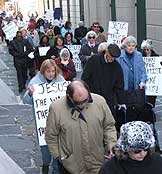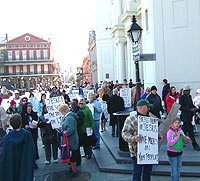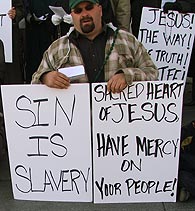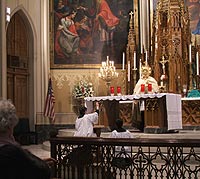
Quarter turned many a head.
It was early December and many old friends were around the table in lively conversation after months of being scattered across America as part of the “Katrina Diaspora.” Stories of personal adventures and misadventures, loss and separation from family and friends, were bantered back and forth.
Everyone had just returned from the First Saturday devotions at St. Patrick’s in downtown New Orleans. The devotions had helped put these dramatic events in a more spiritual perspective.
At a certain moment, the conversation turned to the topic of rebuilding New Orleans. However, the main concern was not just reconstructing damaged buildings or a devastated economy, but the much needed spiritual and moral rebuilding of one of America’s oldest cities. Questions arose: What should be done? What should we do?
Things were definitely not good before Katrina. In fact, the moral picture was getting worse by the year. Few had realized just how bad things were before the great hurricane. It was then that one of those around the large table, related a detailed and horrifying account of what had happened during the 2005 Mardi Gras in the French Quarter:
On January 22, 2005, the Krewe du Vieux, a Mardi Gras reveling group, opened the Mardi Gras season. Its floats and characters targeted Jesus Christ, the Blessed Mother and the Catholic Church with obscenities and blasphemy.
One float’s “king” was described by The Times-Picayune (online edition) as: “The ‘King of the Jieuxs for Cheesus’ and his consort, ‘JAP (Jieuxish American Princess) for Cheesus’ wave from the Krewe du Jieux’s cheese-themed float. The ‘Virgin Bubbe, Mother of Cheesus’ – the Krewe Grandmother – was also honored on the float.”
Another float was described as “The Mystic Krewe of Inane ‘Welcomes Ewe to the Flock,’ with a centerpiece pork chop bearing the image of Jesus.” Signs on the float mockingly proclaimed “He Is Our Shepherd,” “He Died for Ewe” and “Ewes for Jesus.”
The blasphemies did not stop there. There was a float too obscene to describe fully, called “Turning Wad into Wine” involving a male organ and a jeweled chalice. Was this some diabolically perverted allusion to the Eucharist, since 2005 was the Year of the Eucharist?
Finally, there was an indecent parody of Our Lady of Prompt Succor, Patroness of Louisiana, who miraculously saved the city in the War of 1812. She is especially invoked under this title in times of hurricanes. One character from the 2005 parade was a woman with fake breasts exposed over which is written: “Our Lady of very Prompt Succor.”

The lamentations on the swelling moral decadence of New Orleans, a city with unique Catholic roots, changed to indignation. Moreover, those present at the table decried the fact that the world held a warped view of their city based on the images coming from Bourbon Street and Mardi Gras in the French Quarter. This is not the New Orleans most residents want to leave their children and grandchildren.
Around the table were New Orleanians returning from Texas, Tennessee, Colorado, Illinois, Michigan, the Carolinas, and Florida. While part of the “Katrina Diaspora,” they all had experience firsthand just how people perceived their beloved city. It was not a pretty picture….
The Topic Then Moved to Plans for Action
Ora et Labora. The expression came to mind. The famous quote of Saint Benedict who lived as the decadent Roman Empire was slowly collapsing. The Benedictines were later a major influence in the renewal of civilization and culture. Their program was a balance of contemplation and prayer on the one hand, with action and work on the other (hence, ora et labora). The new New Orleans needed a renewal of its spiritual and moral foundations.
For years the Crusade for the Conversion of Greater New Orleans, lead by Mrs. Nancy Albert, Mrs. Cynthia Hemelt, Dr. Charles and Pat Taggart, and many other New Orleanians, has organized First Saturday devotions in churches of the city. Members of the American TFP had often joined them. With prayer, fasting and even all-night vigils over a decade, the group has sought to attain the graces of Heaven for the conversion of their beloved city. How many disasters were averted, how many souls returned to God, how many sins were prevented by those prayers and sacrifices will only be known in the next life.

As Crusade members steadily returned to their city, they had come to the growing realization that in addition to prayer must be added an effective action for change. It must be peaceful, prayerful and legal, but a public action.
Thus, sitting around the table, the leadership of the Crusade for the Conversion of Greater New Orleans decided that an act of public reparation was necessary for the blasphemies committed during the 2005 French Quarter Mardi Gras. This act would publicly beg pardon for outrages performed within the shadow of the Cathedral of St. Louis, wherein dwells Jesus Christ in the tabernacle.
On Sunday, February 12, the day after the first 2006 French Quarter Mardi Gras celebration, nearly 100 Catholics gathered in the former Carmalite chapel (today Center of Jesus the Lord) to pray for forgiveness and conversion.
From there, a Rosary Walk of Reparation straight through the French Quarter turned many a head with the unfamiliar sight of Catholics carrying handmade signs and reciting the rosary of the Blessed Virgin Mary. The sound of prayer echoed down Orleans Street, moving toward the majestic statue of the Sacred Heart of Jesus. Passing by the Archbishop’s temporary residence, the protesters gathered in front of the locked Cathedral of St. Louis to recite a prayer of atonement to Our Lady of Prompt Succor, one target of the 2005 blasphemies. The next stop was at the monument to Saint Joan of Arc, patroness of New Orleans. Then passing St. Mary’s and the old Ursuline convent, the large group of “prayer warriors” returned to the starting point. Some still made it to St. Patrick’s Church for a closing solemn benediction.

the Rosary Walk.
In face of so many blasphemous and lewd Mardi Gras “celebrations,” the Rosary Walk of Reparation was the first such public action of protest and reparation in the post-Katrina era. It was a fitting way to start rebuilding. It is only a beginning, a small step for a huge work that must be done. However, New Orleans has supernatural help that few other cities can claim. If faithful Catholics persevere in efforts like these, they can count on the heavenly aid of so many saints who walked the streets of New Orleans: Saint Frances Xavier Cabrini, Saint Katherine Drexel, Saint Phillipine Duchesne, Blessed Francis Seelos, Venerable Henriette Delille and others. May they come to the aid of battered New Orleans in this time of trial and need.
Our Lady of Prompt Succor, hasten to help us!
St. Joan of Arc, the Maid of Orleans, pray for us!

